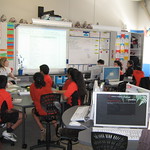Teaching in the new era
I am the daughter of first generation immigrants; as so,
my family’s previous generation all grew up in Colombia. As I was reading transforming
learning with new technologies I had the opportunity to talk to my grandma
and she told me; back in her time the only technology they had was a radio and
it only worked at night time, which was when they turned the town’s electricity
on. My mother grew up with electricity, radio and line phones, she eventually
learned to use computers as an adult and worked at the airport utilizing her
computer skills. I grew up with the television and as a teenager used the
computer to write papers for school; I barely used the internet. Now I used the
internet on a daily basis, text all day and take online classes. All of this is
a contrast to my son who thinks everything is touch screen and at a seconds
reach, if he wants to watch a video or if he wants to play, he will get the
tablet or phone and find what he wants on his own and he is only two years old.
My son is part of the digital childhood, something that surprised me was that
it was estimated that in 2015 there will be 10 billion 1.1 tech tools, more than
the world population 7.5 billion (trasforming learning with new technologies,2013),
and still there are kids in the world dying of hunger. I work at a high school
and as I see every day, teenagers use their phone constantly while they are
eating, while going from one class to another and even when they are in
classroom doing their assignments. Technology is embedded in our brains and as
a 2014 teacher I believe it would be easy for us to transition student into
learning provided by technology tools. Students are experts with technology and
if we can give them new concepts in a fun and interesting way they would surely
be more receptive to all the new material.
As an online student I constantly browse the web for anything that I need
to do and don’t know how to do it. 21st century technology enables
students to be more independent, since a classroom student only gets to ask a
question every 10 hours, they can search anything that they had a hard time
understanding in class on the web; it could be a smartphone, tablet or laptop.
As future teachers we have many technology aids that allows us to be better
educators, the knowledge in the subject along with our pedagogical studies will
allow us to integrate technology and as a result students will be able to use
their everyday abilities to learn many concepts that at times are really hard
for students to digest.
For me technological teaching tools are an everyday concept, I work with
special needs kids and the way they learn is mostly with technologies. I have
seen the immense progress that some of this kids have and how they are able to
solve problems like sorting, cause and effect events and basic math problems
all with lessons that are engaging and set for each of their own developmental
ages. After you model for them what needs to be done on the screen they are
able to follow, expand and sometimes go beyond what was taught and all because
technology allows them to be independent and be able to communicate with the
teacher. As an ESE teacher I would see the constant need to develop new apps
and lessons that allow the students to perform everyday activities more
independently.
As I remember my k-12 education, I find mix feelings and insist that some
old educational instruments are still relevant. I personally like the smell of
books and enjoy reading a paper book rather than an e-book. The interaction
that I got from my face time classes was very enjoyable and I am an interactive
learner, I like to integrate a little of everything plus hearing other people’s
point of view makes me more receptive to new concepts. As I find my digital
identity and set my learning goals for students I think I will have fun using
technology as a means of acquiring concepts.
Resources:
Maloy, R., O'Loughlin, R., Edwards, S., & Woolf, B. (2013). Transforming
Learning with New Technologies. 2nd Edition. Boston, MA: Pearson Education
Inc.

